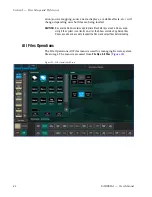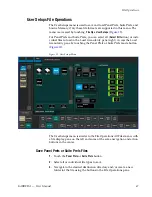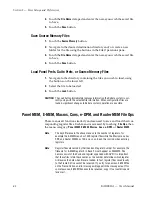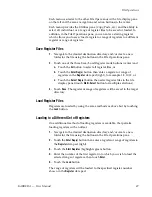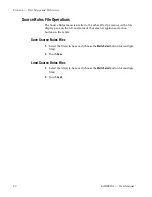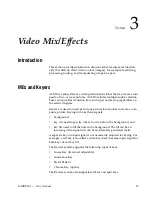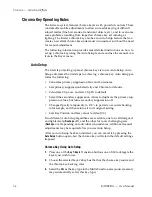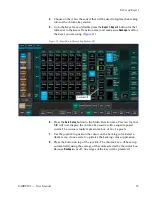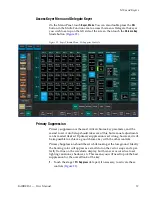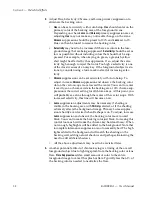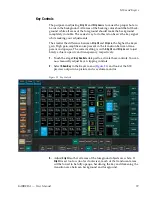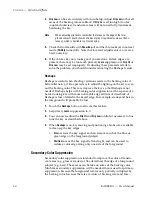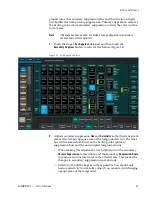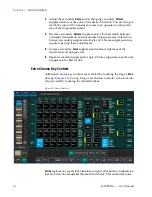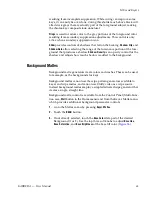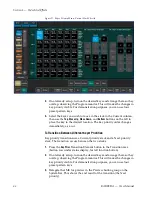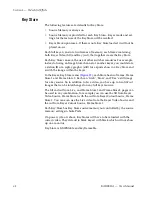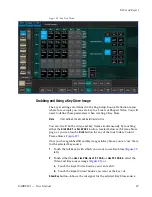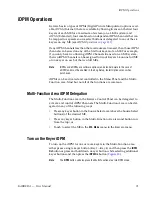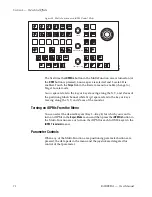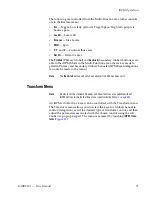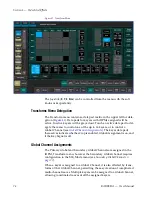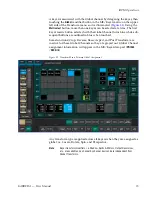
60
KARRERA — User Manual
Section 3 — Video Mix/Effects
4.
Clip Low
can be set accurately with Auto Setup. Adjust
Clip Low
so that all
areas of the backing color are black. If
Clip Lo
is set too high (too far
counter-clockwise), translucent areas will be forced fully translucent,
hardening the key.
Note
When adjusting clip levels, remember that areas on the edge of the fore-
ground subject should show as shades of gray. Gray indicates areas of trans-
lucency, which is desirable in chroma keying.
5.
Check the final results with
Show Key
off and the chroma keyer in normal
mode (
FG Only
turned off). Note that incorrect adjustments can create a
hard, noisy key.
6.
If the chroma key now looks good, you are done. If dark edges are
present, there may be too much primary
Luma
suppression or
Clip Hi
or
Clip Low
may be set improperly. If adjusting these parameters fails to
solve the problem, you should consider activating the Reshape feature.
Reshape
Reshape is useful when shading variations exists in the backing color. A
better alternative, if time permits, is to adjust the lighting on the set to even
out the backing color. This may improve the key so that Reshape is not
needed. Reshape helps with backing color suppression at the expense of a
harder looking key with more noticeable edge artifacts.A drawback of
Reshape is loss of detail in the keyed edge. For example, smoke and hair in
the foreground will probably be lost.
1.
Touch the
Reshape
button to activate this feature.
2.
Set primary
Luma
suppression to 0.
3.
You can now readjust the
Clip Hi
and
Clip Low
controls if necessary to fine
tune the key as described above.
4.
When
Reshape
is on, key resizing and positioning also become available
to clean up the key edges.
•
Size
narrows the key signal and can remove much of the blue or
green edge on the foreground subject.
•
Position
moves the key signal left and right, and can be used to
reduce a color edge along only one side of the foreground.
Secondary Color Suppression
Secondary color suppression is intended to improve the color of translu-
cent areas (e.g., glass or smoke) or fine detail near the edge of a foreground
subject (e.g., hair). These areas can be take on some of the backing color.
Much less secondary suppression will be needed than is used for primary
suppression, because the foreground color is only partially corrupted by
the backing color. Because there is a mixture of backing color and fore-
Summary of Contents for KARRERA
Page 1: ...KARRERA VIDEO PRODUCTION CENTER User Manual Software Version 4 0 071880500 MARCH 2012 ...
Page 3: ...KARRERA VIDEO PRODUCTION CENTER User Manual Software Version 4 0 071880500 MARCH 2012 ...
Page 14: ...14 KARRERA User Manual Contents ...
Page 16: ...16 KARRERA User Manual Preface ...
Page 52: ...52 KARRERA User Manual Section 2 User Setups and Preferences ...
Page 126: ...126 KARRERA User Manual Section 3 Video Mix Effects ...
Page 156: ...156 KARRERA User Manual Section 4 Switcher Control ...
Page 216: ...216 KARRERA User Manual Section 6 Switching Basics ...
Page 286: ...286 KARRERA User Manual Section 7 Advanced Operations Figure 157 Copy Swap Menu ...
Page 315: ...KARRERA User Manual 315 Image Store Stills Figure 184 Freeze Mode Button ...
Page 352: ...352 KARRERA User Manual Section 7 Advanced Operations ...
Page 360: ...360 KARRERA User Manual Glossary ...

